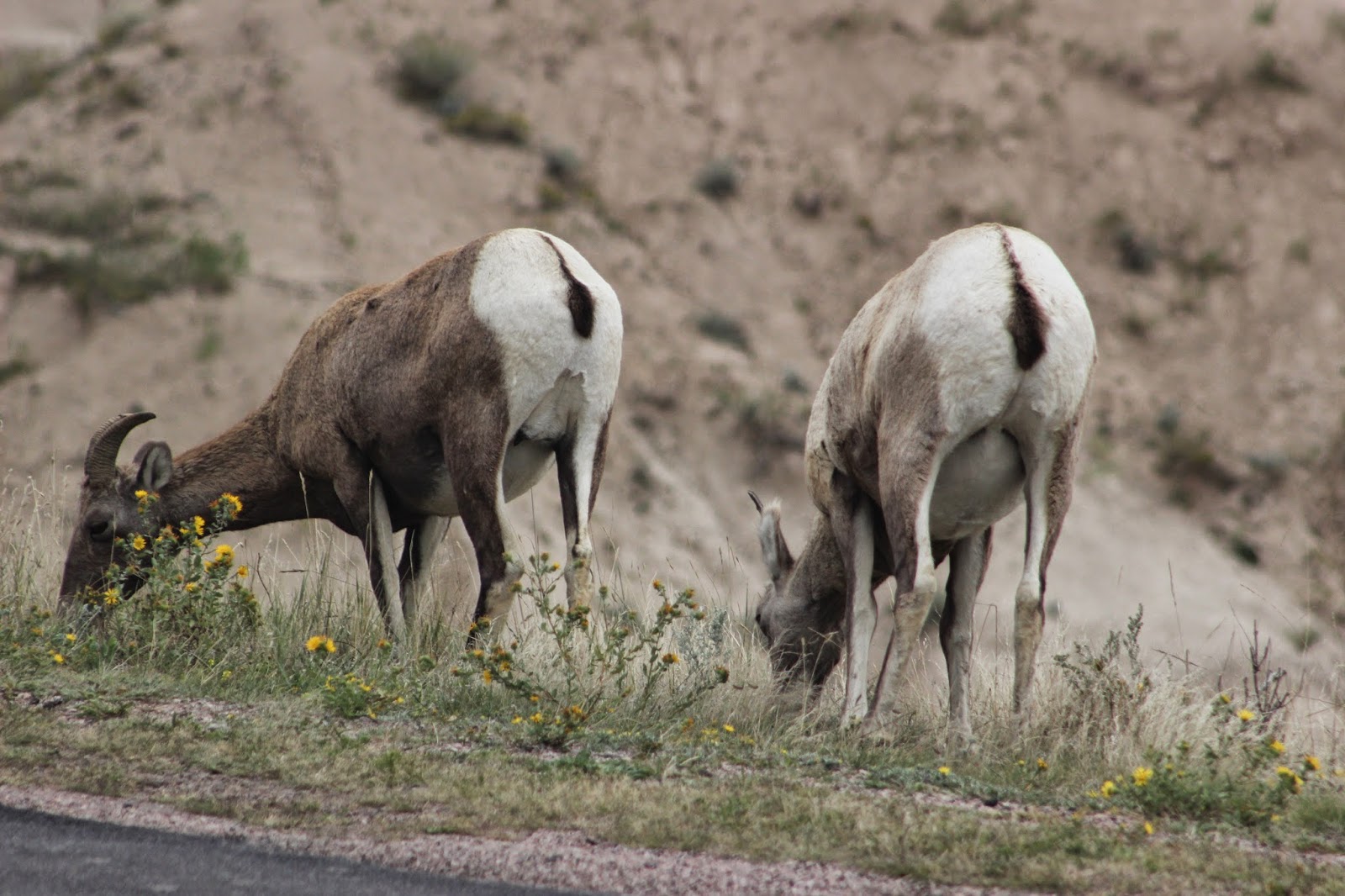When I think of the word "Badlands," I think of South Dakota, but I was surprised to learn that it is a common noun as well as a proper noun. "Badlands" are defined as dry, colorful, sedimentary rock-dominated terrains that have been sculpted by wind and water. They have steep slopes, canyons, ravines, hoodoos, and little vegetation. They are difficult to navigate by foot (but easy by hoof for mountain sheep). In addition to Badlands National Park in South Dakota, there are badlands in North Dakota, Wyoming, Nebraska, Colorado, New Mexico, and Utah. Outside the United States, there are badlands in Canada, New Zealand, Italy, Spain, Argentina, and Taiwan. Who knew?
South Dakota's Badlands National Park covers 244,000 acres, or about 380 square miles. About 64,000 acres of the park is protected wilderness area, and it is one of the sites of the reintroduction of the black-footed ferret, the most endangered land mammal in North America. (The black-footed ferret was declared extinct in 1979, but a small population was discovered in 1981, captured, and bred in captivity from 1987 to 1981 before being released into the wild. Why do I care so much? Because we had a pet ferret--though not a black-footed one--as a pet when we were newlyweds. Nasty-smelling critter.)
Back to our trip. When we entered the Badlands, it looked like this:
But all of the sudden deep gouges opened up in the rolling prairie to reveal this:Many of the roads skirt the upper perimeter of the canyons, and viewpoints allow tourists to survey the formations from above.
I had been to these overlooks once before in 1975 with my family, including my 80-year-old Oma, seen in the photo below with my brother Dave and me:
It was fun to return with my hubby almost forty years later:
I'm pretty sure that I've changed far more than the rock formations!
Some patterns in the stone remind me of smocking on a little girl's dress:
Brilliant yellow flowers manage to thrive in the sandy, dry soil and the contrast with the browns and pinks of the stone is almost jarring:There are a some places where the road winds down into the formations, giving a different vantage point:
The heavy, ominous clouds provided an appropriate background for the menacing geology:
These broad, heavy, grey and pink rounded rocks that seem to float in green marshes remind me of the hippo pools we saw in Kenya and Tanzania:
More smocking, seen from a wooden pathway
There are several of these walkways in the park
They are much easier on the feet than the alkaline soil with its course vegetation would be, and probably help prevent a few rattlesnake bites every year:
We didn't see any of the black-footed ferrets the park is known for, but we did see these bunnies, although the first one didn't move, no matter how close we got, which was a bit creepy:
Of course, there was a nice complement of prairie dogs:
We saw a few bison in the distance, but then we saw one really close up. It is a bit startling to come around a bend in the road and discover that someone (or something) has already laid claim to your turf:
The campground had this helpful warning sign:. . . but I'm not sure these campers got the message. You could pay me $10,000 and I wouldn't camp here:
Strange that we didn't see anyone enjoying a picnic. Maybe that was because the bison like to scratch their itches on the picnic shade supports:
The big surprise in Badlands National Park was the number of bighorn sheep we saw:
With just a few exceptions, they were ewes or babies:
The cars didn't seem to bother them at all:
This ewe has a tracking collar like the one we saw in Custer State Park:
That doesn't look like a comfortable piece of jewelry, does it?
Bigger herds stayed out in the fields:
. . . but they kept turning their backsides to us:
We preferred the ones that walked next to our car and made photography easy:
The suave center part makes them look like Johnny Depp:I only have a few pictures of this oh-so-studly ram (which Bob viewed from behind and identified as male, but which I could tell was male just by his I'm-the-king-of-the-Badlands stance):

While a ram's horns will continue to grow and curl, a ewe's won't get much bigger than this:
"Be careful, Junior! Don't get too close to the edge! You might fall in!"

"But Mom! All of my friends are down there!"
"Please??? Just until it gets dark?"
We were gobsmacked by the sight of these mountain sheep traversing the precipice on miniscule, barely perceptible and sometimes even invisible ledges. They traveled slowly but with incredible grace on the vertical surfaces. These are not small animals, and balancing their large, heavy frames on the crumbling cliffs can't be easy.
I think there are THREE sheep crammed into a very shallow cavity. Where is that fourth one below supposed to go next?How did they get from the cavity to the top?
Watching these animals maneuver was as intense as any Hollywood movie:
We loved our time in the Badlands. There is a mystical, surreal quality to the landscape, and it is heightened by late afternoon and evening lighting.
As the sun dropped lower and lower in the western sky, the colors intensified, taking on an other-worldly hue:
It was a transcendental way to finish off a day already full of mystery and wonder:
The burning horizon brought to mind Robert Frost's poem "Fire and Ice." This day definitely ended in fire.


























































Love your pictures late in the day with the intense colors. Particularly liked the Badlands for the bighorn sheep.
ReplyDeleteI never knew Badlands existed in so many places. Beautiful pictures, love the scenery and the animals. I'd love to make a return trip there.
ReplyDelete